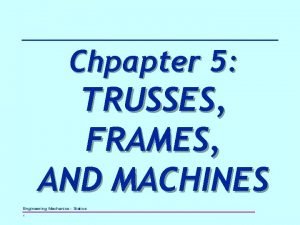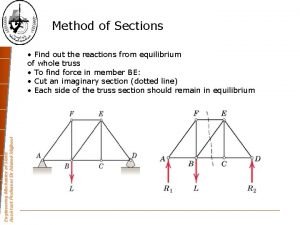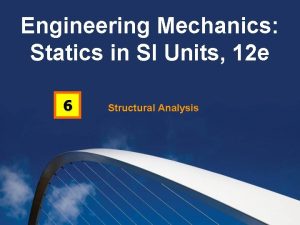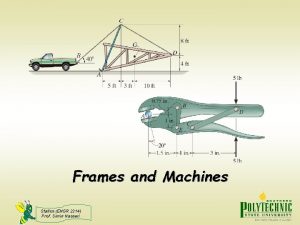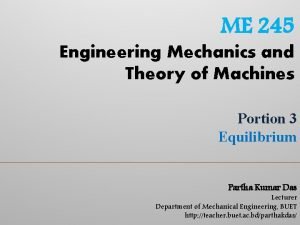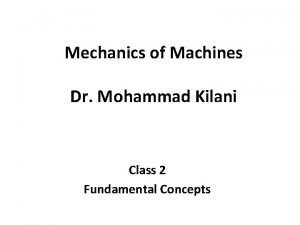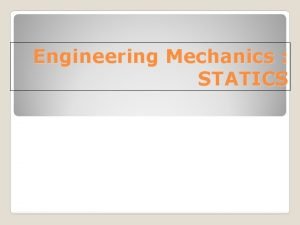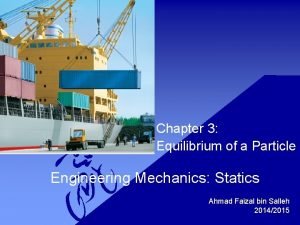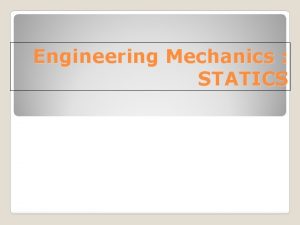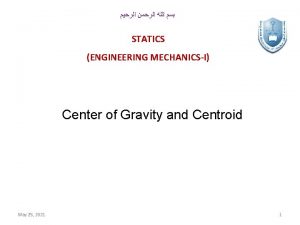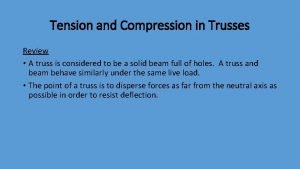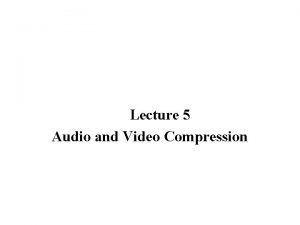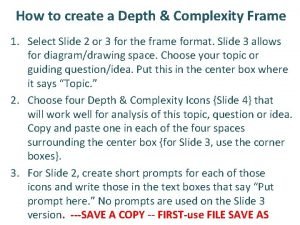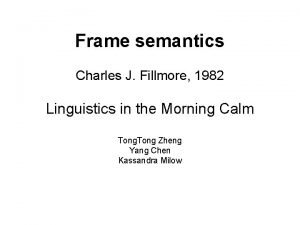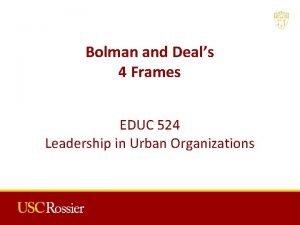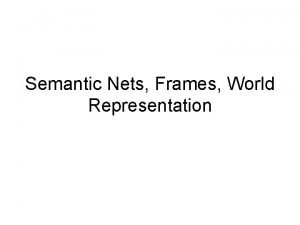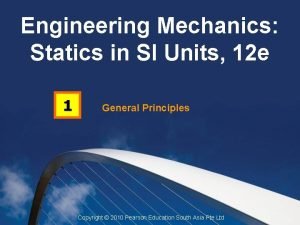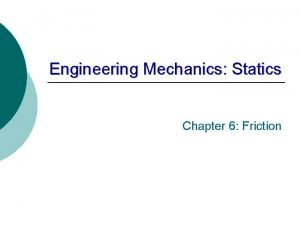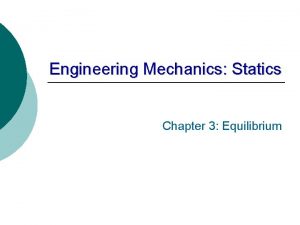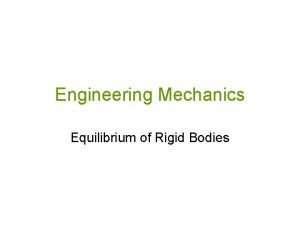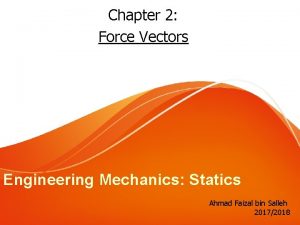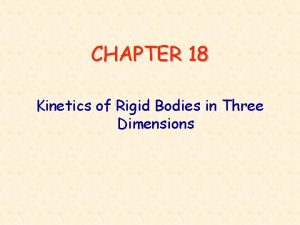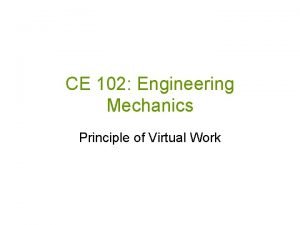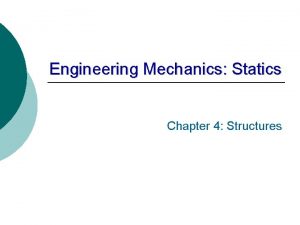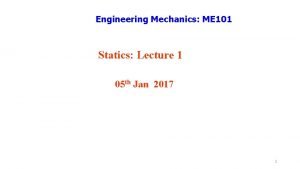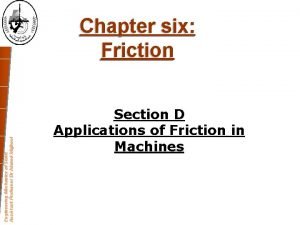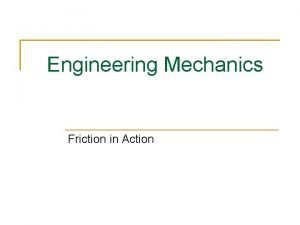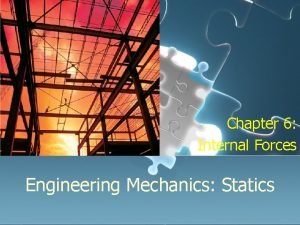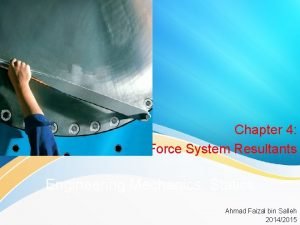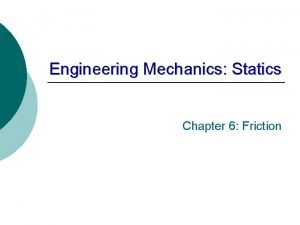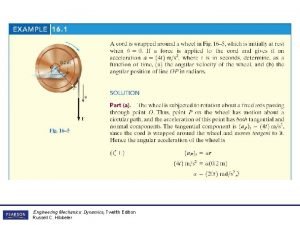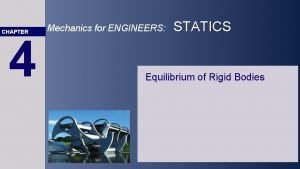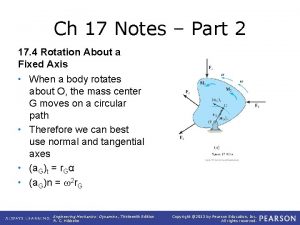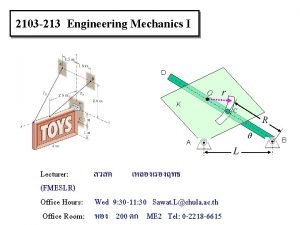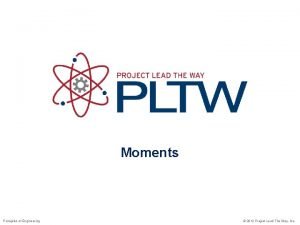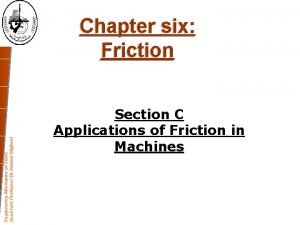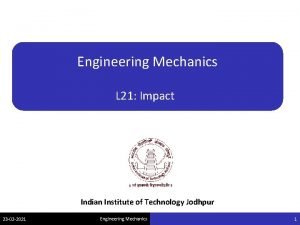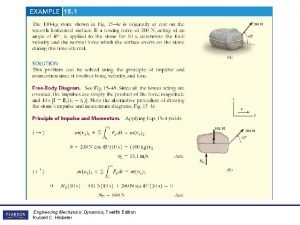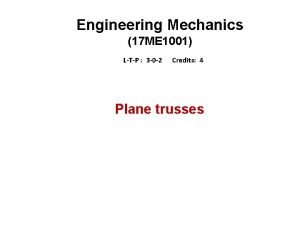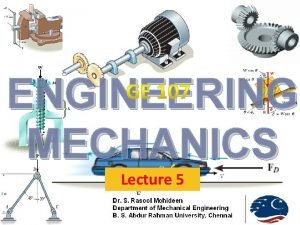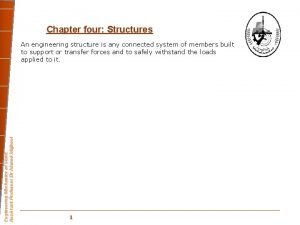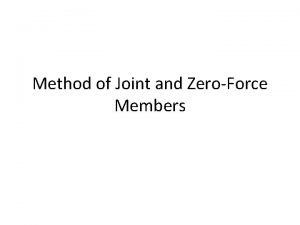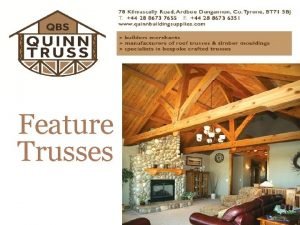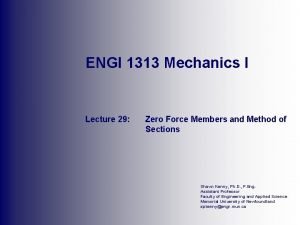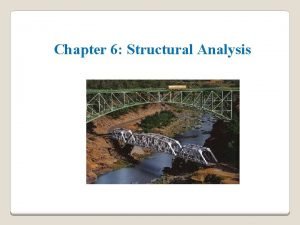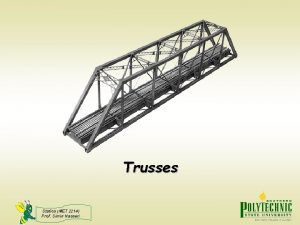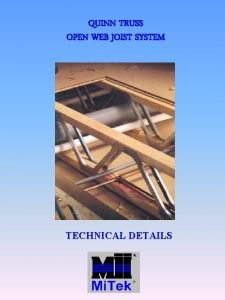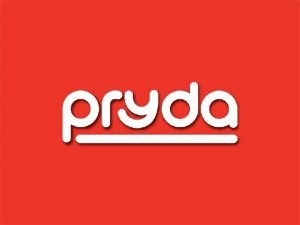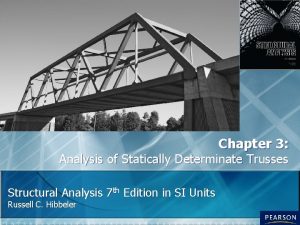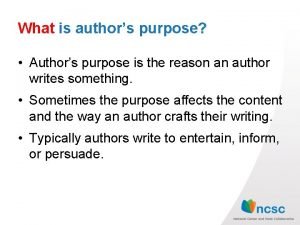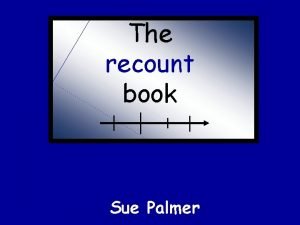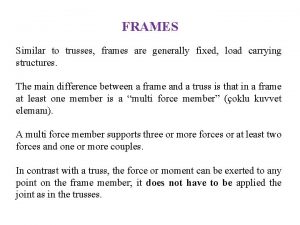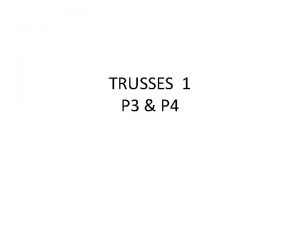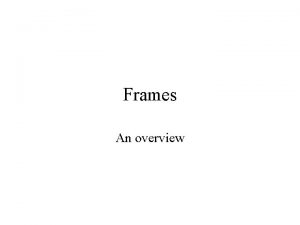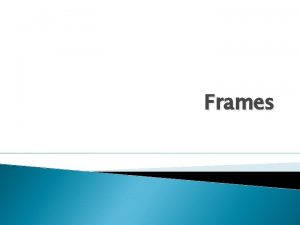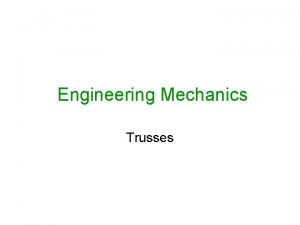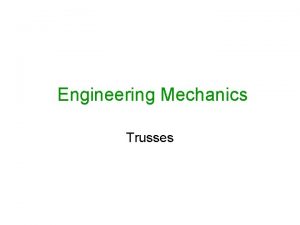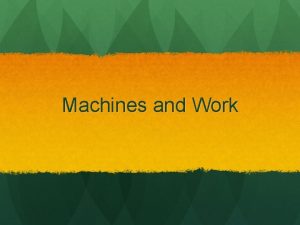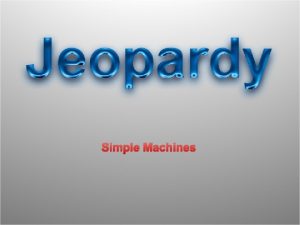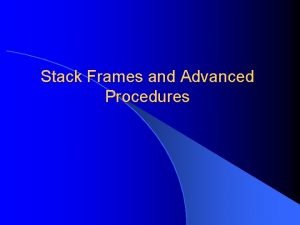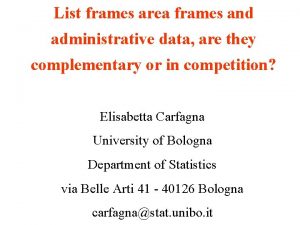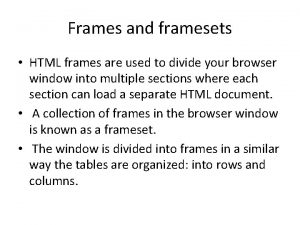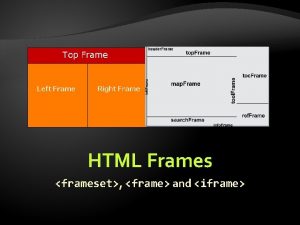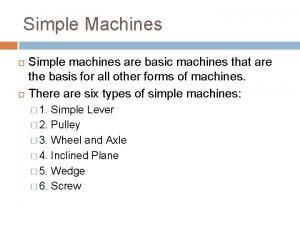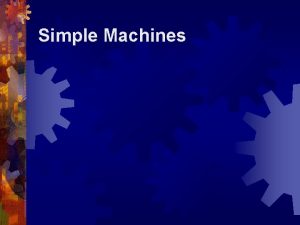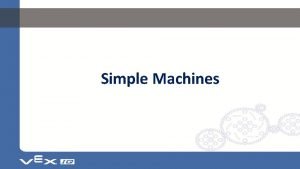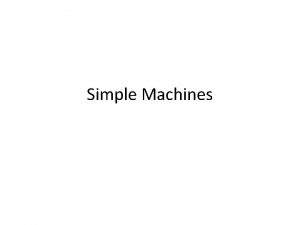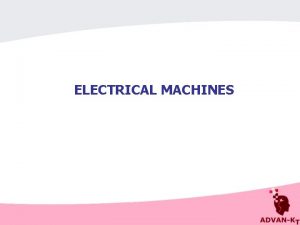Chpapter 5 TRUSSES FRAMES AND MACHINES Engineering Mechanics






























































- Slides: 62

Chpapter 5: TRUSSES, FRAMES, AND MACHINES Engineering Mechanics - Statics 1

TRUSSES 2

www. bookspar. com | Website for Students | VTU NOTES | QUESTION PAPERS 3

USE OF TRUSS STRUCTURES IN AVIATION A 300, Europe, 1972 4

DIFFERENCE BETWEEN TRUSSES AND FRAMES Connection by riveting, moment-resistant 5

DIFFERENCE BETWEEN TRUSSES AND FRAMES Trusses Frames Members are subjected to tension/compression only At least one member is subjected to bending, shear or torsion Composed of rods Composed of bars Usually more simple to calculate, more weight effective Usually more simple to manufacture, and to place in tight layout 6

Plane truss Space truss

Frames • A frame • has at least one multiforce member, • is stationary, • and is designed to support/resist loads. 8

Machines • A machine • has at least one multiforce member, • is not stationary, • and is designed to transmit loads from one thing to another. 9

Definition of a Truss • A truss is a framework of members joined at ends with frictionless pins to form a stable structure. • • Bolted Basicorshape is a triangle. welded connections are assumed to be pinned together. • Only two-force members are considered. • When forces tend to pull the member apart, it is in tension. When the forces tend to compress the member, it is in compression.

Types of Trusses Engineering Mechanics - Statics 11

Engineering Mechanics - Statics 12 http: //www. caltruss. com/products. htm Yet More Trusses

A truss is held in position by the supports and the loads are applied only at joints. The free body diagram of a member shows that it is acted upon by two equal and opposite forces. The hinged joint permits members to rotate with respect to each other and hence the members are subjected to purely axial forces. T T Tension Member 13

C C Compression Member The convention for internal forces, i. e. , the action of forces in the members on the joints is shown. T TENSION C COMPRESSION 14

ANALYSIS & DESIGN ASSUMPTIONS When designing both the member and the joints of a truss, first it is necessary to determine the forces in each truss member. This is called the force analysis of a truss. When doing this, two assumptions are made: 1. All loads are applied at the joints. The weight of the truss members is often neglected as the weight is usually small as compared to the forces supported by the members. 2. The members are joined together by smooth pins. This assumption is satisfied in most practical cases where the joints are formed by bolting the ends together. With these two assumptions, the members act as two-force members. They are loaded in either tension or compression. Often compressive members are made thicker to prevent buckling.

THE METHOD OF JOINTS (Section 6. 2) A free body diagram of Joint B When using the method of joints to solve for the forces in truss members, the equilibrium of a joint (pin) is considered. All forces acting at the joint are shown in a FBD. This includes all external forces (including support reactions) as well as the forces acting in the members. Equations of equilibrium ( FX= 0 and FY = 0) are used to solve for the unknown forces acting at the joints.

STEPS FOR ANALYSIS 1. If the truss’s support reactions are not given, draw a FBD of the entire truss and determine the support reactions (typically using scalar equations of equilibrium). 2. Draw the free-body diagram of a joint with one or two unknowns. Assume that all unknown member forces act in tension (pulling the pin) unless you can determine by inspection that the forces are compression loads. 3. Apply the scalar equations of equilibrium, FX = 0 and FY = 0, to determine the unknown(s). If the answer is positive, then the assumed direction (tension) is correct, otherwise it is in the opposite direction (compression). 4. Repeat steps 2 and 3 at each joint in succession until all the required forces are determined.

Method of Joints Example

Method of Joints Example

Zero Force Members (ZFMs) § TWO-Member Version • When only TWO members form a NON-Co. Linear truss joint and NO external load or support reaction is applied to the joint then the members MUST be ZERO-FORCE members. § THREE-Member Version • When THREE members form a truss joint for which two of the members are Co. Linear and the third is forms an angle with the first two, then the NON-Co. Linear member is a ZERO-FORCE member provided NO external force or support reaction is applied to the joint – NOTE that The Co. Linear members carry EQUAL loads. Engineering Mechanics - Statics 20

Zero Force Members (ZFMs) § Truss members that can. NOT carry load are called Zero Force Members. § Examples of Zero Force Members (ZFMs) are the colored members (AB, BC, and DG) in the truss shown at Right Engineering Mechanics - Statics 21

Zero Force Members (ZFMs) § Again Consider § FBD for AB & BC Engineering Mechanics - Statics 22 § Summing the forces in the y-direction in the AB FBD shows that FAB must be ZERO since it is NOT balanced by another y-force. § With FAB =0 Summing forces in the x-direction shows that FBC must also be zero

Zero Force Members (ZFMs) § Again Consider § The FBD for DG Engineering Mechanics - Statics 23 § Summing forces in the y-direction in the DG free-bodydiagram, reveals that FDG must be zero since it is not balanced by another y-force

ZERO-FORCE MEMBERS ( If a joint has only two non-collinear members and there is no external load or support reaction at that joint, then those two members are zero-force members. In this example members DE, DC, AF, and AB are zero force members. You can easily prove these results by applying the equations of equilibrium to joints D and A. Zero-force members can be removed (as shown in the figure) when analyzing the truss.

ZERO – FORCE MEMBERS (continued) If three members form a truss joint for which two of the members are collinear and there is no external load or reaction at that joint, then the third non-collinear member is a zero force member. Again, this can easily be proven. One can also remove the zero-force member, as shown, on the left, for analyzing the truss further. Please note that zero-force members are used to increase stability and rigidity of the truss, and to provide support for various different loading conditions.

There is a simple relationship between the number of joints (j) and the number of members (m) is established as where, m = 2 j-3 m is number of members, j represents the number of joints and 3 represents the external support reactions.

n If m = 2 j – 3 Perfect truss n If m < 2 j – 3 Deficient truss n If m > 2 j – 3 Redundant truss

Example 6. 1 Determine the force in each member of the truss and indicate whether the members are in tension or compression.

Solution • 2 unknown member forces at joint B • 1 unknown reaction force at joint C • 2 unknown member forces and 2 unknown reaction forces at point A For Joint B,

Solution For Joint C, For Joint A,

Solution For Joint C, For Joint A,

Solution • FBD of each pin shows the effect of all the connected members and external forces applied to the pin • FBD of each member shows only the effect of the end pins on the member Copyright © 2010 Pearson Education South Asia Pte Ltd

EXAMPLE Given: Loads as shown on the truss Find: The forces in each member of the truss. Plan: 1. 2. 3. 4. Check if there any zero-force members. First analyze pin D and then pin A Note that member BD is zero-force member. FBD = 0 Why, for this problem, do you not have to find the external reactions before solving the problem?

EXAMPLE (continued) D 450 lb 45 º FAD 45 º FCD FBD of pin D + FX = – 450 + FCD cos 45° – FAD cos 45° = 0 + FY = – FCD sin 45° – FAD sin 45° = 0 FCD = 318 lb (Tension) or (T) and FAD = – 318 lb (Compression) or (C)

EXAMPLE (continued) Analyzing pin A: FAD 45 º A AY FAB FBD of pin A + FX = FAB + (– 318) cos 45° = 0; FAB = 225 lb (T) Could you have analyzed Joint C instead of A?

GROUP PROBLEM SOLVING Given: Loads as shown on the truss Find: Determine the force in all the truss members (do not forget to mention whether they are in T or C). Plan: a) Check if there any zero-force members. b) Draw FBDs of pins D and E, and then apply EE at those pins to solve for the unknowns. c) Note that Member CE is zero-force member so FEC = 0. If you didn’t see this simplification, could you still solve the problem?

GROUP PROBLEM SOLVING (continued) FBD of pin D From geometry, tan-1(1/2)=26. 57 Y 600 N D X Analyzing pin D: → + FX = 600 – FCD sin 26. 57 = 0 FDE 26. 57 FCD = 1341 N = 1. 34 k. N (C) (Note that FCD = FBC!) + FY = 1341 cos 26. 57 – FDE = 0 FDE = 1200 N = 1. 2 k. N (T)

GROUP PROBLEM SOLVING (continued) FBD of pin E Y FDE 900 N E X 45 FEA Analyzing pin E: → + FX = 900 – FEB sin 45 = 0 FEB = 1273 N = 1. 27 k. N (C) + FY = 1200 + 1273 cos 45 – FEA = 0 FEA = 2100 N = 2. 1 k. N (T) FEB

Example 2 D Truss § SOLUTION PLAN § Using the method of joints, determine the force in each member of the truss. Engineering Mechanics - Statics 39 • Based on a free-body diagram of the entire truss, solve the 3 equilibrium equations for the reactions at E and C. • Joint A is subjected to only two unknown member forces. Determine these from the joint (or pin) equilibrium requirements. • In succession, determine unknown member forces at joints D, B, and E from pin equilibrium requirements. • All member forces and support reactions are known at joint C. However, the joint equilibrium requirements may be applied to check the results

Example 2 D Truss § SOLUTION • Based on a free-body diagram of the entire truss, solve the 3 equilibrium equations for the reactions at E and C. Engineering Mechanics - Statics 40 § So-Far, So-Good

Example 2 D Truss § Joint A is subjected to only two unknown member forces. Determine these from the pin (or joint) equilibrium requirements. § There are now only two unknown member forces at joint D. Engineering Mechanics - Statics 41

Example 2 D Truss § There are now only two unknown member forces at joint B. Assume both are in tension. § There is one unknown member force at joint E. Assume the member is in tension. Engineering Mechanics - Statics 42

Example 2 D Truss § CHECK • All member forces and support reactions are known at joint C. However, the joint equilibrium requirements may be applied to check the results. § Engineering Mechanics - Statics 43

A Real Truss Joint Idealized 2 in Tension, 3 in Compression Engineering Mechanics - Statics 44

6. 4 The Method of Sections • • • Used to determine the loadings within a body If a body is in equilibrium, any part of the body is in equilibrium To find forces within members, an imaginary section is used to cut each member into 2 and expose each internal force as external Copyright © 2010 Pearson Education South Asia Pte Ltd

6. 4 The Method of Sections • • Consider the truss and section a-a as shown Member forces are equal and opposite to those acting on the other part – Newton’s Law

6. 4 The Method of Sections Procedure for Analysis Free-Body Diagram • Decide the section of the truss • Determine the truss’s external reactions • Use equilibrium equations to solve member forces at the cut session • Draw FBD of the sectioned truss which has the least number of forces acting on it • Find the sense of an unknown member force

6. 4 The Method of Sections Procedure for Analysis Equations of Equilibrium • Summed moments about a point • Find the 3 rd unknown force from moment equation

Example 6. 5 Determine the force in members GE, GC, and BC of the truss. Indicate whether the members are in tension or compression.

Solution • Choose section a-a since it cuts through the three members • Draw FBD of the entire truss

Solution • Draw FBD for the section portion

Sample problems 6. 3 Determine the force in members FH, GH, and GI of the roof truss shown

SOLUTION: • Take the entire truss as a free body. Apply the conditions for static equilibrium to solve for the reactions at A and L. 30 m tan α = FG GL = 8 m = 0. 5333 15 m α = 28. 07º

Force in member GI • Pass a section through members FH, GH, and GI and take the right-hand section as a free body. • Apply the conditions for static equilibrium to determine the desired member forces.

Force in member FH Force in member GH 15

Space Trusses Engineering Mechanics - Statics 56 • An elementary space truss consists of 6 members connected at 4 joints to form a tetrahedron. • A simple space truss is formed and can be extended when 3 new members and 1 joint are added at the same time. • In a simple space truss, m = 3 n − 6 where m is the number of members and n is the number of joints. • Conditions of equilibrium for the Ball-and. Socket joints provide 3 n equations (no moments). For a simple truss, 3 n = m + 6 and the equations can be solved for m member forces and 6 support reactions. • Equilibrium for the entire truss provides 6 additional equations which are not independent of the joint equations.

6. 5 Space Trusses • • • Consists of members joined together at their ends to form 3 D structure The simplest space truss is a tetrahedron Additional members would be redundant in supporting force P Copyright © 2010 Pearson Education South Asia Pte Ltd

6. 5 Space Trusses Assumptions for Design • • Members of a space truss is treated as 2 force members provided the external loading is at the joints When weight of the member is considered, apply it as a vertical force, half of its magnitude applied at each end of the member Method of Joints • • Solve ∑Fx = 0, ∑Fy = 0, ∑Fz = 0 at each joint Force analysis has at least 1 unknown force and 3 unknown forces Copyright © 2010 Pearson Education South Asia Pte Ltd

6. 5 Space Trusses Method of Sections • When imaginary section is passes through a truss it must satisfied ∑Fx = 0, ∑Fy = 0, ∑Fz = 0 ∑Mx = 0, ∑My = 0, ∑Mz = 0 • By proper selection, the unknown forces can be determined using a single equilibrium equation Copyright © 2010 Pearson Education South Asia Pte Ltd

Example 6. 8 Determine the forces acting in the members of the space truss. Indicate whether the members are in tension or compression. Copyright © 2010 Pearson Education South Asia Pte Ltd

Solution For Joint A, Copyright © 2010 Pearson Education South Asia Pte Ltd

Solution For Joint B, To show, Copyright © 2010 Pearson Education South Asia Pte Ltd
 Difference between trusses and frames
Difference between trusses and frames Mechanics
Mechanics Trusses in engineering mechanics
Trusses in engineering mechanics A type truss design
A type truss design Statics machines
Statics machines Simple machines engineering mechanics
Simple machines engineering mechanics Grashof
Grashof Statics centroid
Statics centroid Particle equilibrium in 2d and 3d engineering mechanics
Particle equilibrium in 2d and 3d engineering mechanics Centroid in engineering mechanics
Centroid in engineering mechanics Centroid and centre of gravity in engineering mechanics
Centroid and centre of gravity in engineering mechanics Tension and compression in truss
Tension and compression in truss Cookies frames and frame busting
Cookies frames and frame busting Effect audio
Effect audio Depth and complexity frame
Depth and complexity frame Fillmore 1982
Fillmore 1982 Cookies frames and frame busting
Cookies frames and frame busting Bolman and deal 4 frames
Bolman and deal 4 frames Semantic nets and frames
Semantic nets and frames Engineering mechanics statics in si units
Engineering mechanics statics in si units Cone of friction
Cone of friction Statics chapter 3
Statics chapter 3 What is wrench in engineering mechanics
What is wrench in engineering mechanics Free body diagram in engineering mechanics
Free body diagram in engineering mechanics Force vectors examples
Force vectors examples Motion of rigid body in three dimensions
Motion of rigid body in three dimensions Virtual work done
Virtual work done Engineering mechanics: dynamics chapter 4
Engineering mechanics: dynamics chapter 4 Me 101 engineering mechanics
Me 101 engineering mechanics Centroid statics
Centroid statics Engineering mechanics
Engineering mechanics Belt friction
Belt friction Internal forces in structures engineering mechanics
Internal forces in structures engineering mechanics Engineering mechanics definition
Engineering mechanics definition Friction chapter in engineering mechanics
Friction chapter in engineering mechanics Hibbeler
Hibbeler Rocker statics
Rocker statics Engineering mechanics dynamics
Engineering mechanics dynamics Mechanics
Mechanics Define moment in engineering mechanics
Define moment in engineering mechanics Static mechanics
Static mechanics Direct central impact
Direct central impact Hibbeler
Hibbeler Plane truss and space truss
Plane truss and space truss Dot
Dot Engineering mechanics
Engineering mechanics Zero force members
Zero force members Zero force members in truss examples
Zero force members in truss examples Feature trusses
Feature trusses Zero force member in truss
Zero force member in truss Triple roofing
Triple roofing Applications of trusses
Applications of trusses Trusses statics
Trusses statics Statically indeterminate
Statically indeterminate Steel building parapet walls
Steel building parapet walls Quinn truss
Quinn truss Pryda longreach
Pryda longreach Classify each of the structures as statically determinate
Classify each of the structures as statically determinate What is author's purpose
What is author's purpose The four frames of kindergarten
The four frames of kindergarten The palmer report
The palmer report Sue palmer recount skeleton
Sue palmer recount skeleton What are the 4 frames in kindergarten
What are the 4 frames in kindergarten
